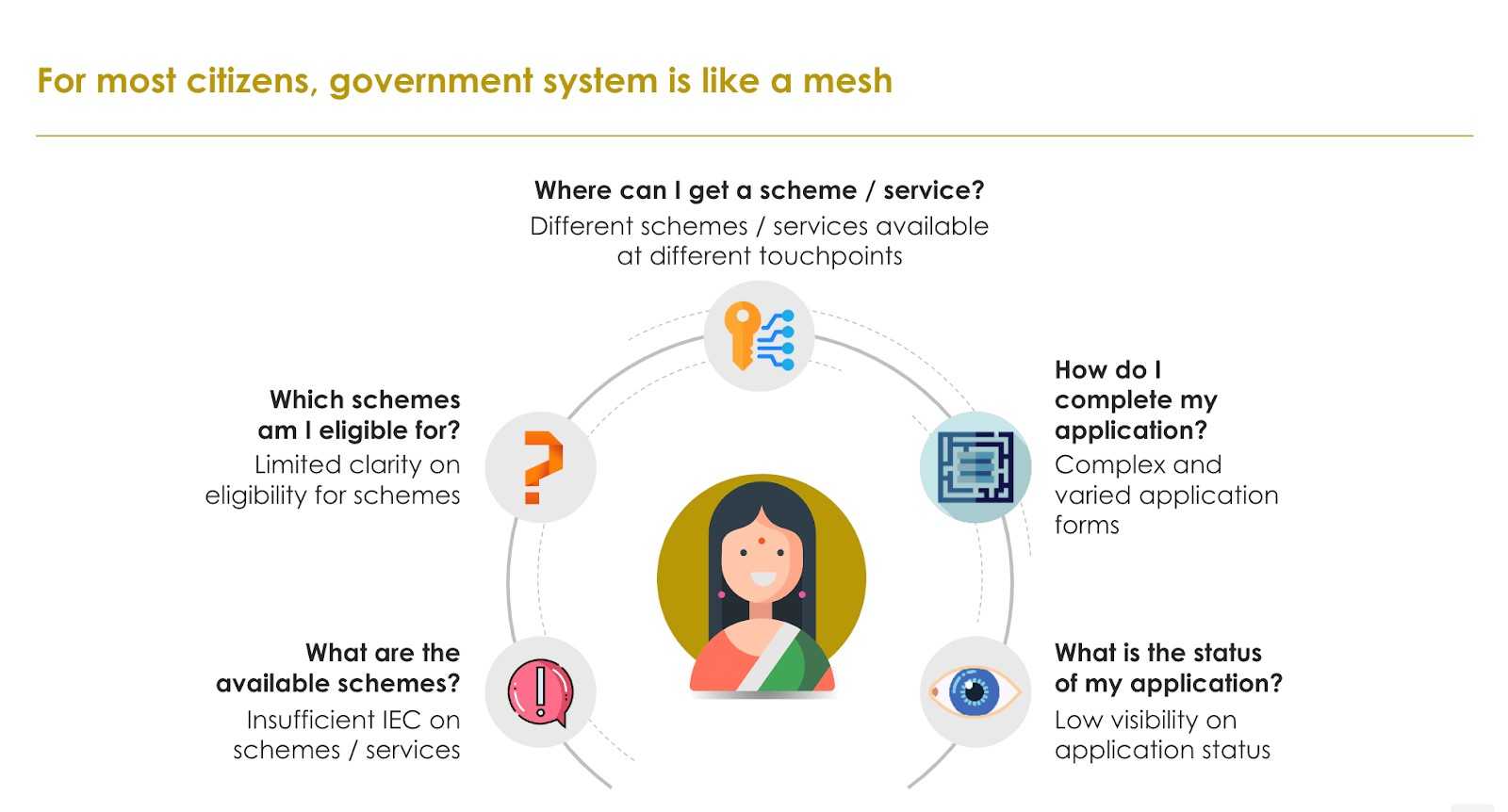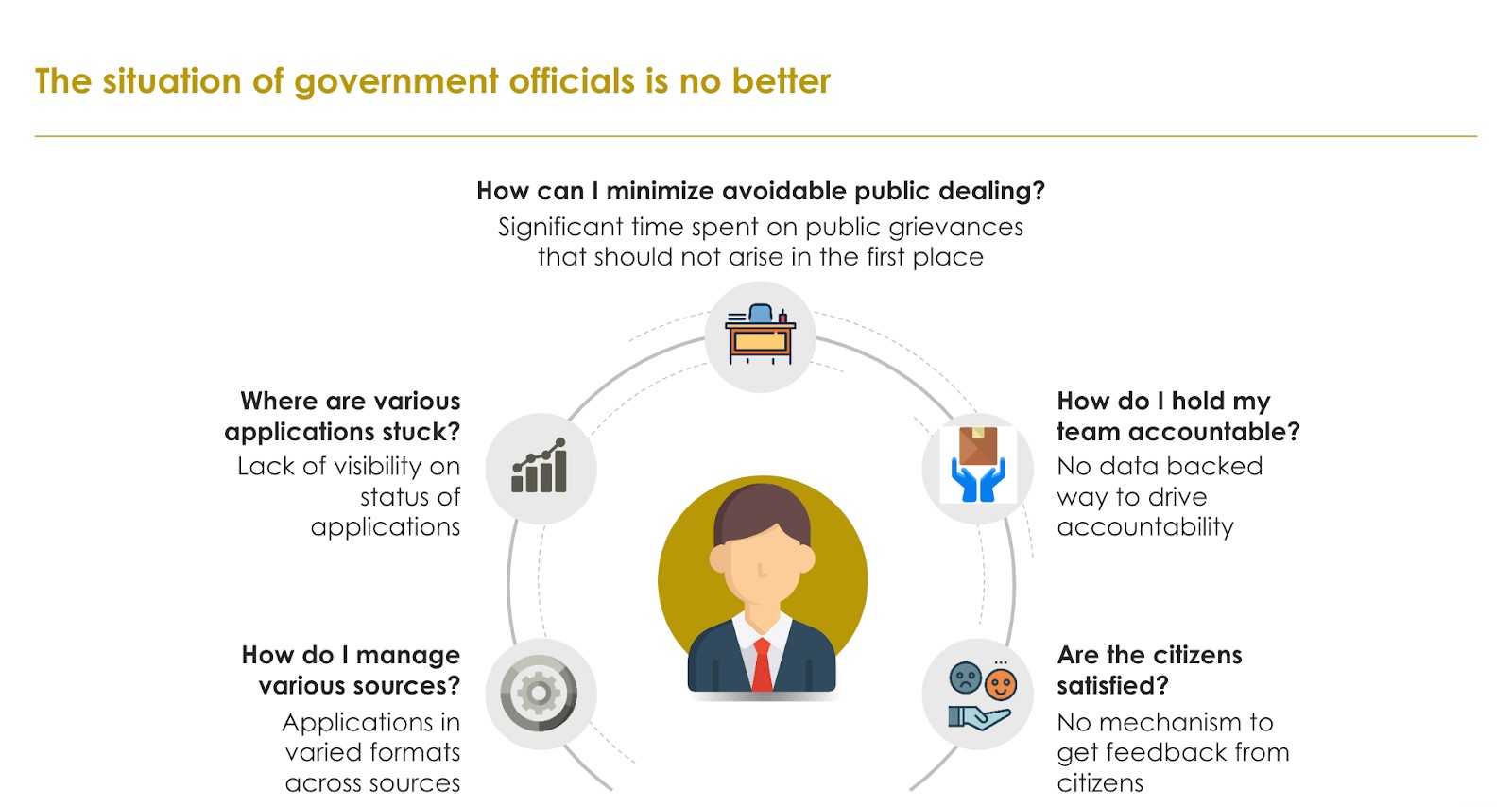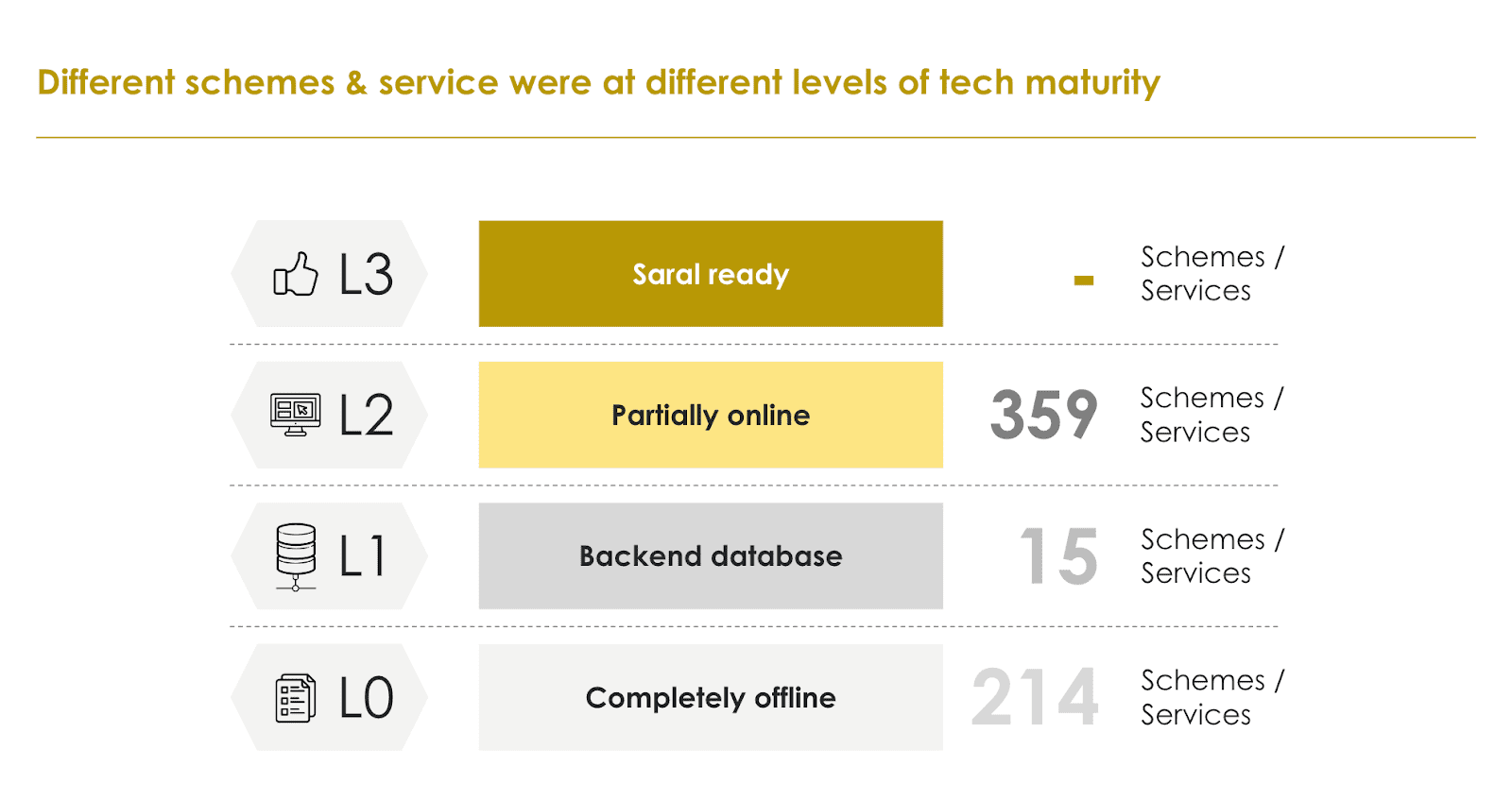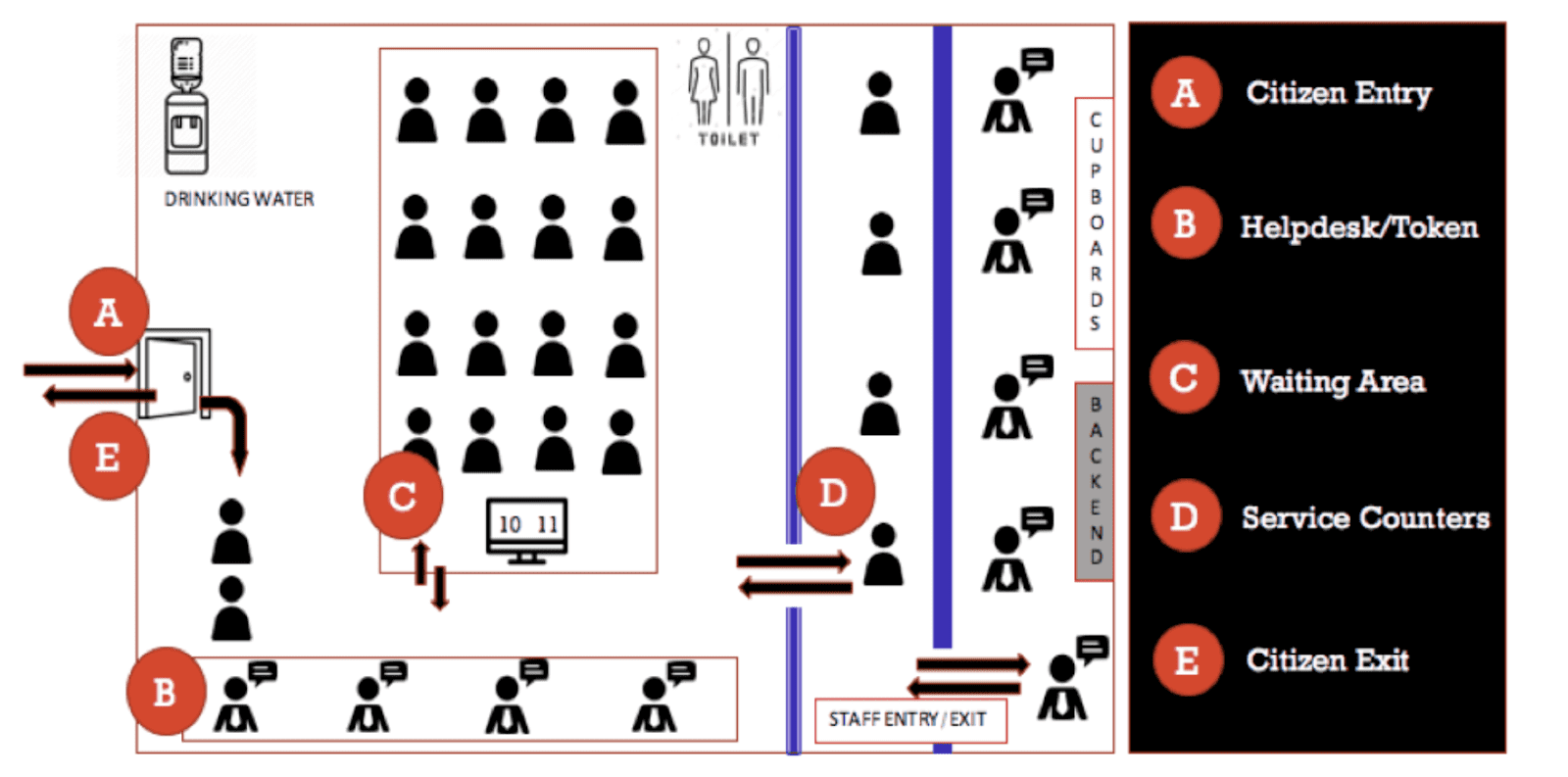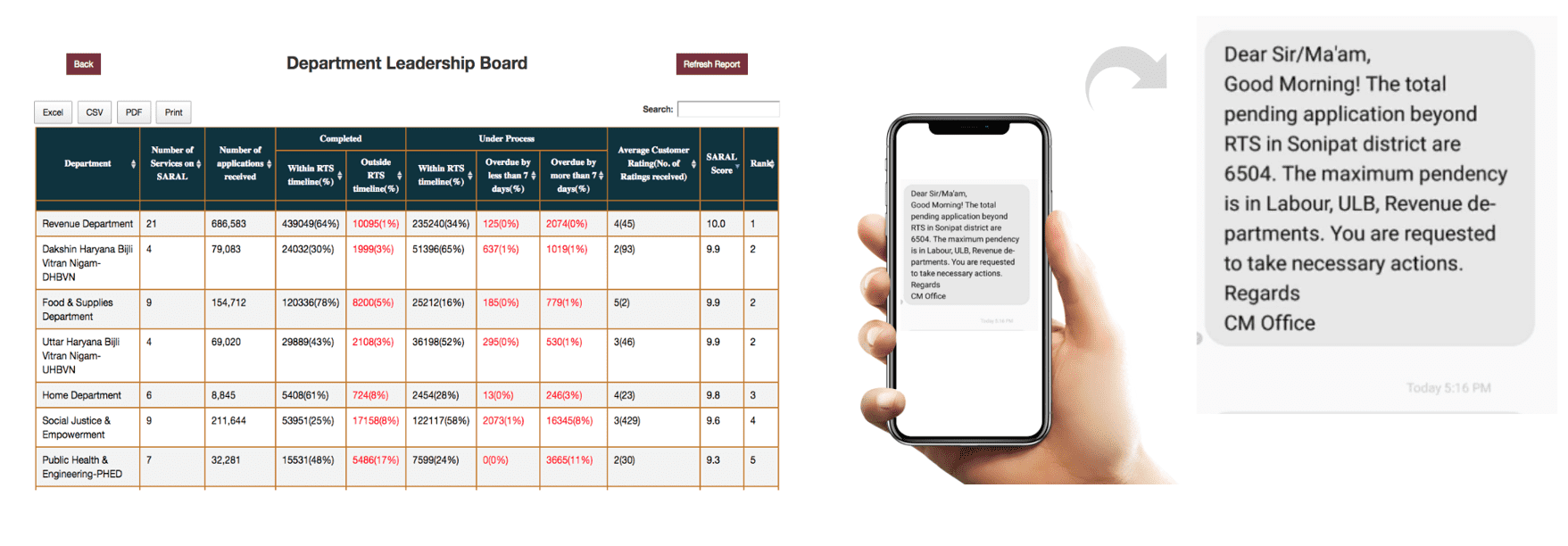Life event based service delivery focuses on the individual citizen or business. Instead of forcing individuals to track down different government departments in response to a life event such as a birth, driving licence issuance, buying a house or death, these departments collaborate to meet citizen needs proactively. This can mean anticipating citizens’ needs, sharing information on the citizen’s behalf, and guiding them through their likely next steps.
Haryana is home to 3 crore + citizens and the government of Haryana offers over 550+ schemes and services across 35+ departments, touching the lives of all its citizens. However, this landscape was marred by several challenges:
Citizen Challenges:
- Lack of awareness and clarity on eligibility for schemes/services.
- Complex application processes and document requirements with multi-departmental involvement.
- Insufficient visibility on application status and feedback loops
Government Challenges:
- Applications received through multiple channels with limited visibility.
- Reduction in efficiency due to significant time spent on public interaction
- Difficulty in tracking and holding accountable for application status
Conceptualising a ‘Saral’ way of life
Antyodaya Saral was conceptualised in 2017 under the Digital Haryana Cell, by the Government of Haryana. Its primary aim was to ease direct citizen-department interactions, thereby increasing transparency and efficiency in service delivery. Key focus areas included:
- Integrated Online Platform: Developing a single integrated online platform for that would be leveraged at all levels of citizen-government interactions, offering a single point of access to eliminate redundancy and reduce processing time while enhancing the user experience.
- Citizen Touch Points: Establishing physical centres at the district & tehsil level and Common Service Centres (CSCs) at the village & ward level.
- Feedback loops and grievance redressal: Ensuring that clear timelines are set (and met) for service delivery while real-time status updates are available for citizens as well as the state government by setting up a service helpline, dashboards and feedback system.
How were things made Saral for the citizens of Haryana
Integrated Online Platform
To start out, all schemes and services were divided into four levels, what the Digital Haryana Cell calls L0, L1, L2, L3. The levels corresponded to the ‘Saral Readiness’ of each scheme or service, L0 being completely offline, L1 being that the scheme has an offline database, L2 being partially online and L3 being ‘Saral Ready’.
There were multiple schemes and services that had been running online for the last 10 years, five years, and were at a technically advanced stage. These schemes ranked higher. On the other hand certain departments were still offering their schemes and services on paper and had not worked on the system even once, these were ranked lower.
To ensure interoperability of systems housed in different departments, NIC’s ‘Service Plus’ product was utilised. Leveraging the Service Plus architecture from NIC, made the platform scalable, configurable, and integrable with existing systems. It ensured that citizens can apply, track, and receive updates on their applications online, significantly reducing the need for physical visits to government offices. With ‘Service Plus’, 526 schemes and services were brought online, on this platform, in 10-12 months.
Citizen Touch Points
Citizen touch points had to be established which included the government service centers– called ‘Saral Kendras’ –at district & tehsil levels and common service centers at the village ward level. Saral Kendras were established with a standardised, citizen-centric layout to enhance the service experience. 115 such centers were established in the state. Key features include:
- Token System: Streamlines the process, reducing waiting times.
- Waiting Area: Equipped with adequate seating, water coolers, and clean washrooms.
- Service Counters: Dual screens ensure transparency as citizens can see the information being entered.
- Help Desk: Provides immediate assistance and clarifies queries.
These centres were designed to provide a hassle-free, single-window experience where citizens can access all schemes and services without the need for multiple visits or interactions. 6,000 CSCs were also established in the state to extend the applications and tracking of the same services in a decentralised manner.
Grievance Redressal
To report grievances about service delivery and to track the status of applications, for a technologically challenged audience a central helpline was built. Until 2017, there were 10-12 departments that had their individual helplines, whereas other departments did not. A single integrated helpline was built to address query and grievances. All grievances, from delay in service delivery to cases of corruption or any unclear reason of rejection get registered at the call centre set up for the sole purpose of service delivery.
Ensuring smooth functioning and efficiency
Ensuring efficient service delivery requires robust monitoring mechanisms. Antyodaya Saral implemented a cascaded review system at various administrative levels:
- District Level: Deputy Commissioners review service delivery performance in their districts.
- Department Level: Heads of departments conduct regular reviews of their respective teams.
- CM Office: The Chief Minister’s Office oversees overall performance and conducts fortnightly reviews.
This multi-tiered review system ensures that service delivery metrics are consistently monitored, and bottlenecks are addressed promptly.
The Right to Service (RTS) dashboard became a cornerstone of accountability in the Antyodaya Saral initiative. Haryana's RTS Act mandates specific timelines for each service. The RTS dashboard provides visibility into compliance with these timelines:
- Application Status: Real-time data on received, pending, and completed applications.
- Timeliness: Metrics on whether applications are processed within the stipulated timelines.
This data-driven approach ensures that government officials are held accountable, and citizens receive timely services. Government officials would have access to a dashboard highlighting all the applications pending on them as well as weekly SMS summary updates, outlining how many applications are pending in their respective jurisdiction.
Besides this each Kendra would also be assigned a Kendra Dashboard and Kendra Score. Kendra Score would take into account the quality metrics of a Saral Kendra, reflecting the kind of experience a citizen has in the Saral Kendra. Those metrics being:
- Processing Time
- Grievance Resolution Time
- Quality of experience of citizen
The Chief Minister's Good Governance Associates (CMGGAs) played a pivotal role in implementing Antyodaya Saral. These young professionals were deployed in each district to facilitate implementation, conduct training, and monitor progress. Their involvement ensured a seamless rollout and effective change management across the state.
Outcomes
Antyodaya Saral has delivered significant tangible benefits for both citizens and government officials:
For Citizens:
- Increased Coverage: 150 high-footfall schemes saw a 15% increase in applications; 40 schemes saw 3x applications.
- Timely Delivery: 85% of 4.6 crore applications processed within Right to Service (RTS) timelines.
- Citizen Satisfaction: Achieved a 4.3/5 rating from over 1 crore citizen feedback calls.
- Reduced Touts: Significant decrease in the role of middlemen due to online processing and transparency.
- Real-Time Updates: 15 lakh+ SMS updates sent monthly, with 5 lakh+ applications received monthly.
For Government Officials:
- Efficient Processing: 100% online application processing across all departments, reducing physical files.
- Improved Visibility: Dashboards provide real-time data on application statuses, pending cases, and service delivery timelines.
- Reduced Public Dealing: Citizens can apply and track applications online or through Saral Kendras/CSCs, minimising visits to government offices.
- Enhanced Accountability: Weekly updates and reviews ensure timely closure of applications and grievances.
Haryana’s SARAL has not only been a state success but has also been recognised nationally for transforming service delivery. Haryana ranked #1 in Citizen Centric Governance Index (‘21) and was also conferred the Digital India Award by former President Sh. Kovind. The initiative also won various other awards such as: Gold Award in Providing Citizen-Centric Service Delivery, Most Innovative Citizen Engagement Award, CSI-Nihilent eGovernance Award (The Award of Excellence).
The long-run success of a programme such as this is highly dependent on the ownership that the state-government showcases towards the solution. In the case of Saral, even in 2023, 10% weightage was given to the Saral score of the district for ranking districts in Haryana for the Good Governance Day Awards. Besides this an auto-appeal system was built on top of the Saral dashboard that has made efficient service delivery a focus in the state. The sustained impact of this intervention on the lives of citizens was also noted in an independent survey conducted by HIPA which showed significant improvement in citizen experience (efficiency, accessibility, perception).
Antyodaya Saral has set a new benchmark in citizen-centric governance, transforming public service delivery in Haryana. By leveraging technology, simplifying processes, and fostering a collaborative environment, Haryana has not only enhanced service delivery but also set a replicable model for other states to emulate. The journey of Antyodaya Saral underscores the power of digital governance in bringing about meaningful change, ensuring that government services are accessible, efficient, and transparent for all citizens.
This blog is part of the Amrit Series, where we bring to you success stories of large scale impact through our work across domains and states. You can learn more about Antyodaya Saral here.

